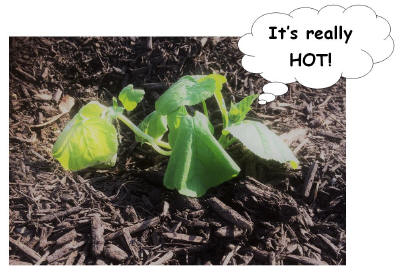(6/16). . . But it doesn’t mean I’ve never seen a zucchini suffering from heat stress. In fact, the poor guy in the picture was suffering during that hot spell we had at the end of May. All the ingredients were there. It was wet during the beginning of May. The rain stopped. It got really hot, sometimes accompanied by a hot wind. There was rain for
some Adams County gardeners, but not me. My soil was dust before I finally saw rain and cooler weather.
 Heat damage is strange, and not all plants show symptoms as obvious as my droopy-leafed squash. There are some plants that tolerate heat quite well. There are others which seem fine until you discover them brown and dry. Most are between these two extremes, and being aware of changes in
your plants can alert you to their need for shade, water or both.
Heat damage is strange, and not all plants show symptoms as obvious as my droopy-leafed squash. There are some plants that tolerate heat quite well. There are others which seem fine until you discover them brown and dry. Most are between these two extremes, and being aware of changes in
your plants can alert you to their need for shade, water or both.
The zucchini in my picture could be considered a good example of putting a plant which likes perfect growing conditions through the worst torture possible. When leaves appear limp, we might want to reach for the hose right away, believing that the plant needs water. Plants of the squash family, however, shut down their water loss quickly in hot
sunny weather. To understand what this symptom is telling me, I need to remember a little botany.
We know that water is taken up by the plant’s roots and moved up the stem and into all the above ground parts like the branches, leaves, flowers, etc. The water carries nutrients, sugars made in photosynthesis, hormones and other important chemicals throughout the plant body. One of the forces acting on the water to pull it through the plant is
found in the leaves.
When the sun is out, photosynthesis is occurring. Since the photosynthetic process requires carbon dioxide and forms oxygen, a byproduct it needs to get rid of, there are pores in the leaves that are open to allow the two gases to move in and out. Water vapor also leaves through the pores, helping to pull the water upward through the plant. Water
taken up by the roots reaches the interior of the leaves where the cells are loosely arranged and material dissolved in the water is free to move around the cells. When the leaf pores are open, carbon dioxide can enter a leaf’s interior space, while oxygen and water vapor leave. The excessive loss of water vapor usually causes the pores to close, resulting in limp leaves.
And then havoc begins. Normal photosynthesis can occur until the carbon dioxide is used up, but oxygen is building up. We know reactive oxygen is not good for our cells, and in a similar way the oxygen released at the end of photosynthesis disrupts plant cell reactions, too. By the way, many phytochemicals we acquire by consuming plant food are
made by the plant to protect itself from reactive oxygen. Chlorophyll, the green, light-capturing molecule necessary for photosynthesis, breaks down in the heat also, and yellowing leaves are another symptom of heat stress.
The leaf temperature is also rising, since its ‘perspiration’ (water vapor) can’t escape and cool the leaf. Most reactions in cells need a protein to occur, and excessively warm temperatures cause cell proteins to lose their effectiveness. This not only interferes with the proteins involved in photosynthesis, but most functions of the plants’ cells
are affected. The plants grow slowly, if at all. They become weak, and root growth and function are affected. In some species pollen becomes non-viable; tomatoes are one example. Chemicals the plants make to protect themselves from insect attack and disease are also affected, leaving the weakened plants vulnerable.
So, what can a gardener do to help her/his plants? The most important thing to do is to be mindful of the weather and soil conditions. Watch the plants and look for signs of wilting, yellowing, or generally unhappy plants. But also watch for dry soil. When plants need water, apply it directly to the roots. If you don’t have a trickle irrigation
system or a soaker hose, put the water at the roots of the plant without getting the leaves wet. The best time to water is early in the morning.
A layer of mulch keeps the soil cool and prevents soil water from evaporating quickly. Dry, sunny soil can be 10 to 20 degrees hotter than the air temperature.
Adding shade helps. The row cover you use as a barrier for insects can also provide some shade. An old sheet or another type of large, light-colored, lightweight fabric will also work. Be sure to place the fabric with enough room over the top of the plants for air movement. Since this is a lot of work, I consider it practical for shorter, fragile
plants, like lettuce. An easier strategy is to plant smaller, fragile plants in the shade of larger plants.
Plan for summer heat when you choose your plants. Finding varieties that are more heat tolerant saves trouble in the long run. There are seed producers that specialize in varieties developed and grown for conditions in the South.
And, as for my poor little zucchini, it is putting forth new healthy growth. Now, if the cooler weather and periodic rain continue for awhile, I can get back to weeding.
Read other articles on gardening techniques
Read other articles on gardening in drought conditions